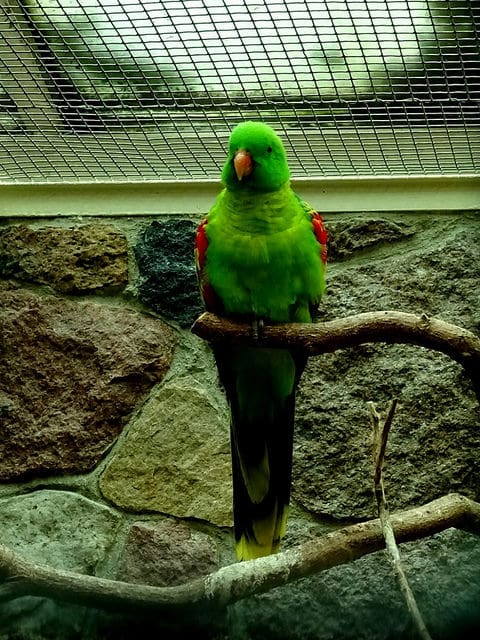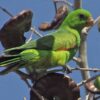Olive-shouldered Parrot
Also known as:
Timor Red-winged Parrot, Timor Crimson-winged Parrot, Timor Parrot
Also known as:
Timor Red-winged Parrot, Timor Crimson-winged Parrot, Timor Parrot

Aprosmictus

jonquillaceus
Size:
35 cm (13.6 in)
Weight:
130 g (4.5 oz)
Subspecies including nominate:
two: A.j. jonquillaceus, A.j. wetterensis
Colour Adult:
A.j. jonquillaceus: Male-bright yellow/green body; dark green with blue tint to mantle and upper back; lower back and rump blue; inner lesser and middle wing coverts yellow tinted with green; outer median and secondary wing coverts red; tail green tinted with green/yellow. Beak orange/red with yellow tip. Eye orange. Female-as in male but mantle and upper back duller green with blue markings absent; outer secondary coverts red tipped with yellow. Eye brown/orange.
A.j. wetterensis: Male-as in jonquillaceus but inner lesser and middle wing coverts green washed with yellow; mantle and upper back more pale green in colour with less blue markings; less red on outer middle and secondary wing coverts; smaller in size. Female-as in jonquillaceus, but upper wing coverts darker green; slightly smaller.
Colour Juvenile:
A.j. jonquillaceus: As in adult female; inner lesser and middle wing coverts green. Eye pale brown.
A.j. wetterensis: As in jonquillaceus, but upper wing coverts darker green; smaller.
Call:
Said to be a series of one-note, abrupt and harsh squawks; also grating tone. Given while in flight.
More Information:
Content Sources:
CITES
BirdLife International
Cornell Lab of Ornithology/Birds of the World
Parrots: A Guide to Parrots of the World, Juniper and Parr, 1998
Parrots of the World, Forshaw, 2006. 2010 edition
Lexicon of Parrots, Thomas Arndt.
Parrots in Aviculture, Low, 1992.
Captive Status:
Rare
Longevity:
Probably similar to Red-winged Parrot, around 40 yrs.
Housing:
Walk-in enclosure, minimum length 3 m (9.8 ft).
Diet:
Small seed mixture such as: canary, oats, safflower; spray millet; limited sunflower seed, dry, soaked or sprouted; sprouted pulses such as mung beans, cooked butterbeans and lentils; boiled corn or maize; green leaves such as: Swiss chard, lettuce, sowthistle, dandelion, chickweed; vegetables such as: carrot, celery, zucchini, green beans and peas in the pod; fruit such as: apple, pear, orange, banana, cactus fruits, pomegranate; nuts such as: hazelnuts, pecans and roasted peanuts, complete pellet.
Enrichment:
Room to fly and exercise, many perches, bathing, foraging items (bird-safe branches, sterilized pine cones).
Nest Box Size:
Nest log 10″ (25.4 cm) wide and 3-4′ deep.
Clutch Size:
4 or 5
Fledging Age:
5-6 weeks
Hatch Weight:
—
Peak Weight:
—
Weaning Weight:
—
World Population:
5000-20,000 mature individuals, decreasing.
IUCN Red List Status:
Near Threatened
CITES Listing:
Appendix II
Threat Summary:
A BirdLife ‘restricted-range’ species. The two main threats to this species are forest loss and degradation, and trapping. Forest cover loss within this species’ range has amounted to 5–7% over the past 15 years. The extent to which this translates into population reduction is difficult to determine partly due to the species’ tolerance to scrubby second-growth habitats and plantations but also its reliance on hollows for nesting. In addition, trapping is considered a significant threat to this species and is likely the cause of its rapid decline in West Timor.
Range:
A.j. jonquillaceus: Timor and Roti Island.
A.j. wetterensis: Wetar Island.
Habitat:
Occurs up to 2800 m (9184 ft). Found in woodland, Acacia savanna, primary and secondary forest. On Wetar also seen in recently logged area near coast.
Wild Diet:
Probably similar to that of the Red-winged Parrot: seeds, fruit, flowers and insects; in mangroves, mistletoe is favoured.
Ecology and Behaviour:
Probably similar to that of the Red-winged Parrot which is found in small groups of up to fifteen individuals; the largest groups forming outside the breeding season.
Clutch and Egg Size:
4 or 5 eggs.
Breeding Season:
Unknown, but probably similar to that of the Red-winged Parrot.
Related Links:
—



![© Dr. Nasser Halaweh [CC BY-SA 2.0] via Flickr An Olive-shouldered Parrot perches in an enclosure](https://parrots.org/wp-content/uploads/2023/01/wpt_Olive-shouldered-Parrot_1178-1-100x100.jpg)